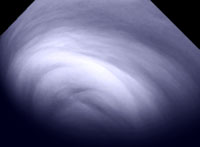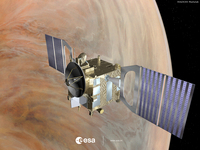The Strength of Venus Lightning Sparks Interest in the Scientific Community.
Despite the great differences between the atmospheres of Venus and Earth, scientists have discovered that very similar mechanisms produce lightning on the two planets. The rates of discharge, the intensity and the spatial distribution of lightning are comparable, thus scientists hope to be able to better understand the chemistry, dynamics and evolution of the atmospheres of the two planets. These results will be presented by Dr. Christopher Russell at the European Planetary Science Congress, on Thursday 23d September.
Early missions, such as the Venera orbiters and probes, followed later by the Pioneer Venus Orbiter and more recently by the Galileo spacecraft, have reported evidence for optical and electromagnetic waves from Venus that could be produced by lightning. This was also confirmed by ground telescopes capturing lighting flashes at Venus. Yet the differences in the two atmospheres led some to claim that lightning on Venus would be unlikely and the topic became controversial. The launch of Venus Express with its magnetometer built by the Space Research Institute in Graz, Austria, has provided a great opportunity to unambiguously confirm the occurrence of lightning on Venus and to study in detail its magnetic field at altitudes between 200 and 500 km.
“Short strong pulses of the signals expected to be produced by lightning were seen almost immediately upon arrival at Venus, despite the generally unfavorable magnetic field orientation for entry of the signals into the Venus ionosphere at the altitude of the Venus Express measurements,” says Dr. Russell of the University of California, USA. The electromagnetic waves that Dr. Russell and his team observed are strongly guided by the Venusian magnetic field and they can only be detected by the spacecraft when the magnetic field tilts away from the horizontal by more than 15 degrees. This is quite unlike the situation on Earth, where the lightning signals are aided in their entry into the ionosphere by the nearly vertical magnetic field.
When clouds form, on Earth or Venus, the energy that the Sun has deposited in the air can be released in a very powerful electrical discharge. As cloud particles collide, they transfer electrical charge from large particles to small, and the large particles fall while the small particles are carried upward. The separation of charges leads to lightning strokes. This process is important for a planetary atmosphere because it raises the temperature and pressure of a small portion of the atmosphere to a very high value so that molecules can form, which would not otherwise occur at standard atmospheric temperatures and pressures. This is why some scientists have speculated that lightning may have helped life to arise on Earth.
On our planet occur about 100 lightning discharges per second, but from any one location we see far fewer. Similarly on Venus we do not see the entire planet and we have to estimate the total occurrence rate with some assumptions about how far one can see. Thanks to the new datasets from Venus Express, Dr. Russel and colleagues were able to show that lightning is similar in strength on Earth and Venus at the same altitudes. “We have analyzed 3.5 Earth-years of Venus lightning data using the low-altitude Venus Express data (10 minutes per day). By comparing the electromagnetic waves produced at the two planets, we found stronger magnetic signals on Venus, but when converted to energy flux we found very similar lightening strength,” reports Dr. Rusell. Also it seems that lightning is more prevalent on the dayside than at night, and happens more often at low Venusian latitudes where the solar input to the atmosphere is strongest.
“Venus and Earth are often called twin planets because of their similar size, mass, and interior structure. The generation of lightning is one more way in which Venus and Earth are fraternal twins,” concludes Dr. Russell.
IMAGES
Press release images available at:
ftp://igpp.ucla.edu/pub/out
ADDITIONAL INFORMATION
www-ssc.igpp.ucla.edu/VenusLightning/Strength_Venus_Lightning.pdf
Venus lightning: Comparison with terrestrial lightning, C.T. Russell, R.J. Strangeway, J.T.M. Daniels, T.L. Zhang, and H.Y. Wei, 2010, Planetary and Space Science (in press).
The Venus Express mission was launched and is operated by the European Space Agency. The magnetic field instrument was built by the Space Research Institute of the Austrian Academy of Sciences under the leadership of T.L. Zhang. C.T. Russell is supported by NASA’s Venus Express Participating Scientist Program.
---------- Post added at 04:17 AM ---------- Previous post was at 04:08 AM ----------
The Many Faces of the Venus Polar Vortex.
A new animation using data from ESA's Venus Express spacecraft shows that the double eye of the giant vortex at Venus's South pole has disappeared. Results of a study that shows the complex, variable dynamics at the venusian south pole will be presented by Dr. Giuseppe Piccioni at the European Planetary Science Congress, on Thursday 23d September.
Orbiting around Venus since April 11 2006, the ESA mission Venus Express, in particular the VIRTIS (Visible and InfraRed Thermal Imaging Spectrometer) instrument on board, is providing an extensive and unique dataset of great scientific importance, spanning from the surface to the atmosphere and its interaction with the solar wind. VIRTIS is perfectly suited to study Venus from orbit through so called infrared atmospheric windows (very narrow holes at selected wavelengths almost transparent and thus able to transmit the thermal radiance from very deep regions into the Venusian atmosphere). Also, it provides information about temperature of the atmosphere and the clouds’ top, from which it is possible to study its dynamics and in particular the polar vortex.
The Pioneer Venus mission observed for the first time in 1980 the elliptical shape of a polar vortex with two apparent centres of rotation, in the Venusian northern hemisphere labelling it the dipole of Venus. The VIRTIS instrument, right at the beginning of the Venus Express mission, observed for the first time a very similar shape in the southern hemisphere. This discovery revealed a North-South symmetry on Venus and, at a first glance, confirmed the stability of the dipole. However, in the course of the mission, systematic observations with VIRTIS showed a large number of different shapes of the vortex, complex configurations with a not well identified stable feature.
“We had ironically observed it in a dipole configuration right at the beginning of the mission. But we soon discovered that this was just a coincidence, since the dipole in reality is not a stable feature on Venus but just one shape among others,” says Dr. Piccioni.
Dr. Piccioni and colleagues also tracked the clouds in the Venusian atmosphere in order to measure the wind speeds of the significant atmospheric “super-rotation” rotating 60 times faster than its solid body. Measuring the solar light as is reflected or transmitted at different wavelengths they were able to probe different altitude levels within the atmosphere. “We found a significant vertical shear (change of winds with height) at low latitudes, with winds doubling from the lower clouds to the clouds’ top,” says Dr. Piccioni. “However, the shear disappeared at higher latitudes, in combination with a decreasing wind speed toward the pole” he adds.
In fact, the polar region of Venus is known for its very peculiar dynamics, quite different than the rest of the planet. A permanent giant vortex, extending more than 3000 km, dominates its dynamics with, on average, an almost solid body rotation. This is quite contrary to the vertical shear in the mid-to-low latitudes, observed by Dr. Piccioni’s team. The ring surrounding the polar region, known as cold collar, acts as a real barrier of separation between the two rotation zones.
Starting from this December, Venus Express will not be alone any more orbiting around Venus, because the Japanese mission Planet-C, launched last May, will join it into the adventure of exploring the mysterious sister planet.
Images and Movies
Image 1: Comparison of 3D prospective views of the Venus’ south polar vortex showing the vortex as it is now (left) and with the dipole configuration (right).. The vertical scale represents the temperature of the clouds’ top, correlated with its altitude. The centre of the vortex is the deepest zone, estimated to be a few km lower than its surroundings. Credits: ESA/VIRTIS/INAF-IASF/Obs. de Paris-LESIA
Animation 1 (gif): A 3D prospective view of the Venus’ south polar vortex at 3.8 microns acquired by VIRTIS. The vertical scale represents the temperature of the clouds’ top, correlated with its altitude. The centre of the vortex is the deepest zone, estimated to be a few km lower than its surroundings. Credits: ESA/VIRTIS/INAF-IASF/Obs. de Paris-LESIA
Animation 2 (gif): A 3D prospective view of the Venus’ south polar vortex with the dipole configuration. The vertical scale represents the temperature of the clouds’ top, correlated with its altitude. The centre of the vortex is the deepest zone, estimated to be a few km lower than its surroundings. Credits: ESA/VIRTIS/INAF-IASF/Obs. de Paris-LESIA
Image 2 (tif): A set of images of the Venus south polar vortex at 3.8 microns acquired by VIRTIS. The images show the temperature of the clouds top at about 65 km altitude. A darker region corresponds to higher temperature and thus lower altitude. The centre of the vortex, approximately at a temperature of about 250K, is the deepest zone, exhibiting the highest temperature of the Venus clouds’ top. Credits: ESA/VIRTIS/INAF-IASF/Obs. de Paris-LESIA

Animation 3 (gif): A movie of the Venus south polar vortex at 3.8 microns acquired by VIRTIS. The set of images show the temperature of the clouds’ top. A darker region corresponds to higher temperature and thus lower altitude. The temperature contrast is the reason of the three dimensional effect of the images. Credits: ESA/VIRTIS/INAF-IASF-/Obs. de Paris-LESIA

Animation 4 (gif): A movie of the Venus’ south polar vortex at 3.8 microns acquired by VIRTIS. The set of images are projected and compensated for the vortex rotation, to show the dynamics within the vortex, which is very complex. It is thus possible to see atmospheric flow with different direction and speed. Credits: ESA/VIRTIS/INAF-IASF/Obs. de Paris-LESIA/Univ. of Oxford

Figure 5 (gif): A movie of the Venus’ south polar vortex at 3.8 microns acquired by VIRTIS. The set of images are projected and compensated for the vortex rotation, to show the dynamics within the vortex, which is very complex. It is possible to see some structure of planetary waves rotating around the vortex. Credits: ESA/VIRTIS/INAF-IASF/Obs. de Paris-LESIA/Univ. of Oxford












